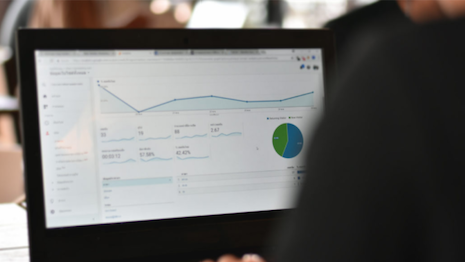As retailers and digital advertisers reel from the COVID-19 outbreak, they are beginning to spend again on Google advertising, according to a new study by Tinuiti.
Many retailers pulled their money away from advertising in the early months of COVID-19, but now are seemingly spending again, bringing numbers close to pre-pandemic levels. The Google Ads Benchmark Report highlights important shifts that Google advertisers are currently seeing, the implications of Google’s search terms update and insights regarding how certain strategies are outperforming others.
“Online demand is soaring as a result of the pandemic, and Google search is where many consumers are turning to search for products that they can order online, as evidenced by the significant growth in Google Shopping ads over the last two quarters,” said Andy Taylor, director of research at Tinuiti. “Luxury brands should make sure they're taking full advantage of the opportunity provided by Google search ads to get in front of consumers this Q4.”
The Tinuiti Google Ads Benchmark Report is based on performance data from Google programs under Tinuiti management, with annual Google ad spend under management totaling over $700 million. Samples are restricted to those programs that have remained active and maintained a consistent strategy over the time periods studied.
All figures are based on same-client growth and the trends and figures included are not meant to represent the official performance of Google advertising or the experiences of every Google advertiser.
Key figures
Advertisers increased spend on Google search ads by 9 percent since Q2 2020, 28 percent year over year. Cost-per-click (CPC) declined only 1 percent in Q3, a drastic difference from the 17 percent decline observed in Q2, as many advertisers such as Amazon ramped up search investment in the quarter, increasing competition.
Shopping spend growth outpaced text ad spend growth, with advertisers increasing Shopping investment 34 percent year-over-year for text ads. Text ads CPC recovered quickly, going from a 16 percent decline in Q2 to a 4 percent increase year over year in Q3.
Online retailer Amazon was the largest Google Ads buyer to increase spend in Q3, which returned to both Google Shopping and text ads in early June. By the end of the quarter, Amazon’s impression share against retailers nearly reached pre-pandemic 2020 levels for Google Shopping.
Some advertisers that were forced to pull back on advertising due to the pandemic have ramped up spending in Q3. While pandemic-related shifts in the auction are certainly important in understanding recent CPC movement, it should be noted that CPC growth was largely trending downward prior to Q1 2020.
 Amazon was a key factor in ramping up spend this quarter. Image credit: Tinuiti
Amazon was a key factor in ramping up spend this quarter. Image credit: Tinuiti
According to the study, phones accounted for 69 percent of all Google paid search clicks in Q3. Tablets have been declining in regards to paid search click share over the last year. While desktop accounted for only 28 percent of clicks, it accounted for 40 percent of spend, as average CPC is higher for desktop than phones.
In September, Google updated its search terms reports, eliminating queries which were deemed as not searched for by enough searchers in an effort toward privacy protection. As a result, the share of spend attributable to search queries declined significantly across phones, tablets and desktops.
According to the data, this update should not be considered a deal-breaker in terms of driving advertisers away from Google, but it is an obstacle to cross.
Advertisers still have visibility into most of the queries accounting for ad spend. Paid search advertisers should continue using search query reports for optimizations now, as well as in recording any known query types which tend to cause issues to use for reference in the long run.
How advertisers fare with Google
Google announced earlier this year that it would end third-party cookies on its web browser Chrome.
While it was a positive development for consumers and data privacy, it came as no surprise to digital marketers. Even before Apple and Mozilla made similar announcements last year about cookie blocking, marketers and ad-tech providers were preparing for this shift in media technology.
Digital marketers will need to adapt their innovative processes and differentiated customer experiences to comply with new standards. They have come to embrace the mobile-first world of today and have even shifted their consumer interactions in that direction (see story).
This month, Google faced an antitrust lawsuit from the United States Department of Justice, which may lead to more complications for digital marketers. The federal government is arguing that the tech giant unfairly dominates online search and advertising to the point at which consumers and competitors are being harmed.
While this lawsuit could potentially last years, brands should begin considering how the outcome might affect their ability to reach their consumer markets, and potentially start focusing on diversifying their advertising strategies outside of search engine placements (see story).
“Past scenarios of Google being removed as the default search engine for a device/browser, such as Mozilla Firefox turning to Yahoo as its default search engine in 2014, indicate that a significant share of users will turn to Google even when it's not the default search engine being used,” Mr. Taylor said. “It’s not the case that Google would necessarily lose all or even a majority of its ad traffic."
{"ct":"2TMIQMYGfFX9wpZncOj4fbWUrlXRszNcz3U+gp1P5Sql61XlXlhV644ruDKomxDQvzglucN00EqM5Fj5lKlAx\/wW3+30XrnRHmH6a+YQuoG+MBxJrnbAPAsJDN29dOJsardX93g6RRBpGLB0Hb4gjXSFXmUsigGd\/e6a0qh+ttBYuJzlSWPLHUnPrIGK\/MoeOFpsB7TP5yh\/S5hiyS8i8dzEMLACRbk\/4nKsOzTaL3XthFf1vBPbnlbqLABhIHhskdsPrUp4QeF\/oMJBPUBxcMFeG06O\/Th5y3MURqGHNO0JYkuUtO5yc7ry29Pki\/Zmv9eZvJQR5ZfOfj1D6dxPiTfr+6lCqj7rlDaKjNLYJ3U4ORb2uKC+8chq+qWK29oOVjYuU7adFVdETrwbQoFP7cVlUXQ4CL6oPtlm5KoNqr7xgqvGWkZvPs5Vvjc2fVY2uKOaVefB3tpCIOW4ASCph4YFA4aO78WInZ7PyNyDF7\/dDc\/n8MryLeS81dLOFdrNNpFwqSCYVo\/cIzSze0giQg4oZwRdKHut4XHUkE7ar0PNB2VURKfkE4XIaE2ZVzy8rOe1tUrzPh9NrZfhcQhho0x6zIxOVuB0o1MRnnD1olvEa9KJc46yNk6MWdHknepIClXZxqUq1K3O4umUuBxZQK6rw\/grdrYrf3xWySaZ1T2Ymxb2TrBGTSmN6mr3piXF+p\/yfv9xdSJHEhUpv8Q2Fg6gHdF65tbtSyOTKNrz9M2QkPbKJn\/iBUfKn67WfmKUe6OfpCvRGS2jQukrrk88YrThZU8o3BzPAgrH4dXk+zySmd0Pc3em6eBi2nd4RCSZ95rhFDlL0nMRtdC+NCEJ739wcnW72rzmUlKx\/\/wD7nkg2gHkBAI5FVuSWJnKslvxxOjfhdtjZlQlRjYWbXs7ClqGuvPafyTUFCKaGUqv8tE4lmEbQtFOWBdeliiv8z5iu\/IOsrxxUQEXL5EXSJZ0wCDl0v4XyhfFooNHIFUk+oemTtNuGrfWRrO9bBhC1l88x0dpnqbLlNBKoziUQldNLUU8B\/Y7UFdtqN\/P3LSu9IsrVWuCvXoY8DH2eG6KXIZDovQZyTd2nj2m7WyKJ3ee030ov8XNJqiss0JHAWphLC1hrLxNKmH7nGTXw+qSLFoKexHaO68Wa6cKO5VeSEjyu7sPMQHGMnSVs+D50rdXBzT6XRgmc9yLQsx+Bj6vu8hy+3edAMEagTeUd\/RQfTuQ\/Hga0Y6RXs21aW1q93W780Mmx8\/jKwvOcFbTVsa6tDcBJ990ivJ2uoO7\/vNNQZ2Ez\/GpEsDrH+tefnizIf392jWI8o2J2kmiKlcdMLfG4dTbrMwwoUburpJqrcn17MMAHc3l5+9yRKF73HWX8PciSaV0AUXgMvZGiGI9rC0EgflbKyXya0ynVb+XvamhLT9Vd3DlvBa3eOrXkHzjTq1NL7iDD7lh8NmSuCzmFo8JnIVkdYTEazkmnWibi8UlWyTC+zu4+bfHSSmaZS5mTwVRdX\/07HzPoE7GI5YP6bk4lpFR1YMel440DyzejOuMCuzk7pAPYFnFCLW8uZXg0qlzG3K86v+1WMuJoEfPctwxytJ\/mFXqJ6YohLJs2G\/NjhV3tpBFdjvTs6HrixhzRYTsLIUo4qfhxdvEruBGQpy+RAM\/eftvfx9+uG91g0lyfZc0aNtYN82nR9ip7wBpnM5Z2YfEHRJ3gsEVb\/\/LZlGwft0EqBN\/DvNF3Ruvt7Ce5f9s8KeKKRPrEjQFcq6OyELJrhkLBCGmp8ZFF7prIPgxDl9ODgVhC\/sWYuBOex\/1StRrpQ1RYcrIoqb8M67v4IfNbEUgPtmyh5px1OWaSNq0tNFkwZTZtDsgDcev\/pbNaR8M3B2BuxcJWoU19kMTl1ytdMjkntiZZJ7SfXqu8CVhJTJ6BQZajqzNqzAST+1xtditH2IO3f9s5Uxahr3UgGcvxPFZCaoelNfCLe9h\/AfUUdGhnira2U9dB8vvaC6169ZExSkFO+k29F1bKCd2h0YLe1FLwLOe\/Q72n\/p73U6WN44wzSdMvjxx3M7QNqOIlA3cvR8FwQe+heAD0+9tDKiJNNYD9uGB3\/ulJbdG1+Iidn4B+NGgmYLw+AIT7PCRyop7zyQTz9Ss6jX2gDCtbcBWSRGGMAGjpDy8XBd5Jbg5vmsnGIVoZLwOcDqDhuuUQkLDN1tYilR6qoWXIdsYvNoor8\/TiLtr2Ps8ImTgnJ77lnkaQBy0tFGIL77fX4HGmWzlLrHtWNTrgYdxMIFneTDPXMyf+JiE0Phm2+z9rXQRj1fz53f1kj0SEdEeJUbnzlQffRD+Mnzd6ChVl6lLFOsNoSvfCYdZkhapW1INQqo29UWfA0FPcuoqs2YrH1vCqvKz0xzmoC1FJ8Uy80vRNhDQetpugfLAnfboa301ZYyCzzaBzex+bck7jd\/ofaOlIpR+U5a\/GEi1ltQ7pKIxscEzMg\/cGNBUTSF84FsQZlE4ipENzg4r\/4dGkWFj09WtCjEJueyAmWBKrZYrTPvCe9vEsJImB2F9WQAbRD3XzrDYKhDKS45zF0hl6HlQB\/h+CKFuOhk12\/df+gck50AzYn8WvERvbmKD6UX7iBpwLuRg\/Wla\/hUg5Z4\/2F3bAT4oZlYgoJrE1P4\/ZVh0yUv2knTRA7Mvsgo350iUH7jNAMlZu2YbW3OlUutMoakZro3y4uQ+ZcshUKmOq\/c4quthMRtPS\/7uQ2e6UX3lJr9JRlqwiOXMgwpgbfkTVQXM7Lqb3fdyAtF965oO0bLhfXZj6iYfDTVu\/woTJf6GQz8eCZf4kz0r4ogL1GT4jVrtd+UmuW7CvdZFx66dQ04NS9cBsa5PAGSiKYuQ1Ot2tPbHd2pXhOZODkoqiHioQU5ab6mzy7qnOhQTc2tfk6+24zUVkpyK3Jzq50kblBQwZEi1UlKiWMZrVRVkO2BVQkgc2ekgy0ags0NhtaFDef0o8a6fh5o8gukWWszxEbpEKhkkTKnGcJfQAMCiR4xWY0g1aQQEFwZVqGl8JzBPRNc8IR8Ix+BcjPdegPNcydnorMx7yoewC0O9W4u3ZoS38NlySNX+LORDDcDY1EQwdWLLpxqpn1xoYA6urYFYDLpMlwwR9Iynl2RAXEXfQNAw7jim9WKy6yo\/g5LrEdOg5zd0jLbzI9rINLob3yBbDJm\/S\/Xq+UT0NMFSh2rixaxwSHCLlUVGJE+P9E+Dt4F\/O3hc9cLTW1gH\/a7Tqy3PaNti1IGyh9MLsMizQ+klli00v98GzFILdJTn9x9NkmZKHFdR+v0mN9BvBqACDaEtLVos8rMMG6FglJ3vH\/ZgLesWlAnUPI\/LYi9WSzkrJM7FV7kOAJPsXtdySxGK2t\/FB9zytwhhAweatfKeajFSCQYg9\/jqavUQciWPhfEf\/EeLw0y3AyLJ2jGTrM9lZiu6axoXFVYamM14AjkjxQzuOpIjwoZjnUsjaYPhTPRNHgPX9z0pBbkXb+ggvQO79Kz0SNRn++NgdRgYm9uLKCpUFNz24hpsAbYPRBSI6pHHSiGJmLcRlMJywwj8ztOX9YbFaNmQRf1rWxKRFCDFQECbismFG+a2vzFA77IQzNaFoPkfSgyZBGfKA4q+0Q5obxcXDe0yFScgZbqeeWNBFyKF1I4h0CMgKrfHVgIqA5S+D0B40wlyFe4rqFABj8bCcVogg1iy+eTV3RF86whILGnH7HQjsmogZm5WB1gwif9hoTkIZRVE3xOi3YbTer5WTyDDIZHpzUo68XhzyteFbNc5g8jIJrydK336ro\/URk9bF2YIb+KqcPg88tm916CTzQqyg\/iHQxUosUKeRj7iXlpLotIl3dzihgH8uO9qUlvfcwNlXQWG3bxcRmXReTidanQx8w9dNtfqBVKLS8TlDiUqCJo8\/LBvCG9kVfOoc9tX\/f9gbePu7VtJ2e+K28GknxQF2XGNmYKn2AB3ug5rUiz6VRSvbrr2WizFM5MgYc\/4eIgoiRNNAqmKNkU8KTjaN1W7B8v\/iNwPiIw3kgYlMWkRoDo+KichTb9F1PE+uo1+JuRShSYv7XMNzFNv0Kw0p3C1hHhXuyrAwKzogfpQamAF+T48YSRf7aAG+XnF8azWMKGLR+NP4OI9sAN\/blxirB3HstbE96pby4qxnjnNHi6ZidHphdnfOABfLqja8fqKDzB6n4IaKGfEUVLxS4SOfRBxmh1PF\/W420s8FliL99\/Nf2PQ03iD1aDBVwReF8NWOgzGo92Yj1G4rtK7ZhSXt3eYdjcL8uQUhLquXgEsirvkdUYJpuC099ENJTGN6TIAA61ULXcrGAHOnfmbAw4jL14KUYbPZAGfsrs4sklmFW3BQ67nkU7o9LHD7e299dHGp2DeoZFkPcXzcR8CWELJtoLv7nE9jwINSJFzZTxzAxFRRwwNC3FM7eTNapEvNpvZdmLQ9eWXRE4K2MTg0jsRhtcnrRW2xMzC5UHJiOyiVVHw+aYPNpcgqozhoHfSQDoMQOibIuBByFVwHwLMVYNKSrsZfAmA4sUfPrx2hb+\/RDLVe3Luy4fJXzJuNxVrO+yQcs9t\/Qrvojlz\/1\/kXiRzcO9ILtDZw\/JD38hOiz19Gy1sS90+nUgaIjDy1RLWiYSMDL\/m6ZVvlo4eOZGtp856mV8GXX+8jARqgADUdy9vZd9k4rfOa2+gdbgjHn3HgSfcv1EgH7MHiO+391oA0JK0QTvADEUpgqIigl0QSj7vhxjA\/70PsAf8wtlaZ8mEkLqpgJf2dCy8oca1VZ1kEvRB6llZykD8OlmyMOO6SyUVdejPO2ZN2fvppfxKv7vsBo5ow3mxji7k098LB+BtOPPoxs9+OA4CUhpgJrw6vUuid+5fjCcnID3UDm6WwFmABNneStow+r2g8bejraqaR9YYygpT7MYNxdVXQBjmizF07\/WOW\/yzSXtbFKVhTeZj59d3KYyhNl3gubjPsT27FB7FJtkNxxnhK87Sn7m4L0fp+EolTGnrWs1NF01uDMZ+\/10LcwvZ04fQnclkfMU41hCxFMNqw8NTs0\/+iOaTTrVEZHx0wq3UMcJ\/HbLrdp1VcBGHa5p2jHwIa1Dub6AY6OBoUzxBamAnrWM\/mkK0WJ5UqNb4\/2JyHJ1dQVZzcK0M\/gtrafQz43rOWD4FgXJ0SmdN4CskHkgXaPze0TW+1f3MS5T76F+nidIUtSJE+OdDcj\/KhVhXAJE5g2VvD2rnkVk6CP2ilB7vA\/x\/l1uZ4VzpVfqD0Cho3uzroFioJ7u4U5JioDSyXSE21pxPoW0gu0Ic8wOgkmi3R5rgK9h7tL4hTcJUduwp4WljaWYXNbcWAe3ls5m54Wsua0jmoHATWUArKsMWrD\/MyTC1PgakfHyuqFgjOArlm1Hq3t\/0d3hdGH9qoDB+w\/f9uRcJ\/oNrN8dxBPfoRZKHUBO9o4S\/O+L0gWCNI4euH9hVJODfZeqTAZNl3DugSGFTVigBvgFsvvhRaOt8LHK3+P6cUIq3ZCNQ4ZKVkZtfAjd12nQ+GmnLQVQEV3c4WGOoTQgRFBsXDseJuNjcxr\/vKo7GUPSiLcufrilpMDquTI+CMPn39720PEAjFf9Gi3crc7OqS0lLBmN2Ifr\/m8dr7HB9GTPJ57lmfGC4Y+NGaqHRdQd8wgWnVYLPsdvE6cyXAfKOz9tFSpHs3xvVxY8m6ndpeIYXaGVPZVrVSLNCWC2oEpYaDQdbIda92\/eLqz0A0hE89ac\/6yTkF1xh\/TAXE5La\/R7ulKAevhZiKvRaU2iGIwckIs8+ucPA2l8uBzv+WcrtWKz7ftdHnHLwVzSuSavLRdCY4qs6doA\/f1bAd9E64Dcdal5vjNlrGbbOoPdaHueEgRs8VPfZ4SS6B9r1ubfvLaGZ0\/C6KiZ\/3yEuVgWjSBykqHdsZUHJsIuPUnHSVR\/mrMtbE3MUP6gHvOTwmdaq1KZcGp3nrO4BQiiZiAcjSLTZQYyV+n+1OrRUn8ScMQOoup\/pYkrKvIPrUjH8BI4XDWY\/CmAGRhPGsAqtmFeMsMbRnGg6TMAtRvpWlylMzvjQhgF9Ok213rFwk0lK9tmmqN9DGjETc6HHIyx1kg\/oMTn2eLskYxqwu4q64VNlGxCuG79azYKIMiYVm4tBOeaHorGF+Gcg9UdTZLpwJ6x4IM9E\/OQgyrFt\/k++OrObV+KCoTMfA5Mekf6KWfBEgPSYo\/7iWBQaZ0k9CM4RcpR54Yd+oLtLDJDXcUMbdZ\/RNVbflTNvT08urKZYdBIVeA0QeJoinmHNT\/DxYzHWIRjmmLJxA1gDthKOJzjg7Wvu8acrSSrxCIyI5E\/BgDVLOrk7nel6ysSqY9i+rV3DF1sPrmW2tK\/GBBnVdPaVGSMQkhIOGKyIVeQjgJbFxrrnDCZHAQyL9\/ar+LigGYRg6AWUDXYa4PRyOLXOxGdYTkryZqf\/wH\/1TO8eDEcCbhfXcsyIg9ulGGrsE2KoXAFAd\/coiaRdsGIMsP8kZQKSa1NoQk7rsAHcNPc6SBOQt2ya97+cUG+2fDcu+wrA\/4GBbphwBfVq4TJUwLN6Rp0pDLGuecK54\/FfrCr84v6NUOKbSWYOD+GeRRwnkNFAtnXGnyjN6bYnLkKVpmIRUq813aGXli7LkI1BhHNWVyQ0jD9hua66D4bIFKCzDOKbGQH25X\/dwWOVTm1HzTCIT68Vqwfels8hdI0AvuBYvQLWjX6HLEYFFcELwTq8zqjQKWfn139w6yxvXUBocANUQHOpBtOK\/04in3+NtsZE6MRBBOnAlpjjPfQp\/njlYxfIOjzCeQbsDidQsVypktLEZpepKqvEGT4vvR4MEswtVF23udCTaCax7a5FfBMNFU\/gBJxsAmEP5BhD686XXY3ryuuuqgI+O0vRHgrkMHQnKdWhhFG3VA7vjiKfaYc9w+CSVcbAEJuxmya6AnyvTw1FVoqef1v42PBFzVMUQZqamRmfx0IeZ4R7uvh+aDvq2RoCMyig2YgNS6Xk9w5StPTvJK2+SVrVuC5d2p3pQ4fRJuA5dU64DBrTncilvMADteEQ+VEBsmZWSAdc3MjKVWOZDRKcKOwaZxwK+vR9fNyl8iezaSKjALilyXKlQlM+91IwpNa+J3Y+Yu2qHF1\/vzN\/zic7uCXjMcTFRgfPFKAjDp1uihXmtxjIU9ey7mdScXeOJjMcmgNDLfz7ayhr2bpqVy8dl\/tXS6BYCM47hs0134K4XWLa9\/O6SGoU4MR9TleSKm7UasUWm1EC\/SptHSf8noNR5bzPCzHWy9\/l0d61YmGMyFQsZEND7BgBs6c6sr8XPXjENh2UybnzHYD9RtsdvsjV6H0KGm3aBok4\/FGo3bHo4865BvbqwruA5iZijiyUCC97uPCmpAeWEa7wv12UgQk8R8MydzgjuezKcXMu\/WuEzUSTfhD3e0gE45Lk62EqOzqik0x7auMOMfZr9AF52+1UCqT4MqidMgQNUtL0wfhmjpRLWWWbCIZAdaovIKPkfZUZyDZn8gbQrg43Xsf2oPgT9Ker8OXPoclAxgfxZuQXy8UJh7TfWOZB6wXqHV2F6UMdhzMJu+ay0tj86QHhrTcIjSIZRkudwonwIioQ6ajYOSjo+TVa8EPxReTVjtIivCnEEkQNYFmpaqrlwTMD7iUcWfPhas3p5kvxvUO4hv5H50l7HeWh39160xMTm\/nfOCOcDqR2\/dRk1CG+YQqOipTd2s8gT3qCjvwx\/YRZfis3jxfn3o3KmfyNBmwuJNTXf1ryEZOKItE5hOMQJoKA2PirYJ5gxJ5zX6mJpoaY2ib+xptOPjDWl2Re4DHA5cls7JHuil3sJ2qKsIoz+0Dt1\/7HGw3VjwFQgbXGmtdXp1ZjBYv+OdExQwv+0soJI+QgUUoHIGboSjt1yNpk7bBXKLTm0kfwfyUpm2s6alewNa6wEHwWj67tboUIo4JKXHLa1jWiEHlKA0hjJaXdmHzthw4urY2mwpVesjyUwWUHLHVz\/w2AkwLALFWvqP\/JY+xuHOGmrSxjOFfwuUBYCH6PmogndFc0jpyq8L8oAbiOEEtBGa\/MfWoJ2IJoQkQ8RS1jiJ0UIZsWBACz+ogJ2AO7UGp3\/CrBEwNqzKAPWyCFUIOncVT748R+6NVaatVLFG2tH2QONFWPewK\/NB5yYrB7AErHbGR5z30yIZWPrJ1MoDKnX0bhieHM4p4IZ5qLsIttwbw539\/5C41pQSOhFtyFYyX3BEmsE2tGAxHZBxNNN3sA4V3XUU074KX7NyB3Y9L+Eg4ci2dq9u6nZ6Pzi06sHuS8\/F2pmhxPym3GKJGdcS7uXHm\/qoLP1y0ucCPx7ISrgV8rpUopeiQWp8ntCfT4CcnIuFUlkwYzAm+ypl1N5\/TaCTOnlL+ZZ9uz4t3oGUFGugWrUh0A5\/W7HnoRJdxq4k5Qu+fwH7nJBnX8ZVgLuLPY9kPMtAD+nQAVy8kwr8d1sppcNPY8t6FglVl\/16yNcOmeuyhwZepdg7n3LL6IU6\/7RA5ljD4YV0A1ZzHnMp36h\/g9mLqHQB+VitMJxSXtsAnJCqrDjNoJkpm07RPLbnkYTWsZ4Z000yslaDAn\/leNBxygyvNg7dd8DHcyj8tjNZvVMrj99n3RMMUs\/Z1EAY0EiQbEsNIcPF\/L+eRqrG5EG4+98+TBcjtyABQENY7dA+Gnez0LrS6ReRKZmyNjHNwrpweJyo0o1zdS15tBH7\/HHTBwaafBilAWOJmLVJ\/ooUP6RrS5yTNV0FmBHmJgRJV20a\/m4rWpLyKtN5FGfSYbNHGf2ubpinul3DRv0im5haC6TqKO6pdohBFkmwcgZ080ga5AWuYBgOhHV9skGBvQlbfX3bPFpq71OIk7kUtpmAfKHUyN\/ArlRxYBSk0YZy8nMLAmpBGfNdZLTvky","iv":"cb00c48747771605d442c7cd35e06c0a","s":"51be8986036a761a"}

 Google Ads Q3 Benchmark Report. Image credit: Tinuiti
Google Ads Q3 Benchmark Report. Image credit: Tinuiti  Amazon was a key factor in ramping up spend this quarter. Image credit: Tinuiti
Amazon was a key factor in ramping up spend this quarter. Image credit: Tinuiti